Experimental Performance Analysis of a Solar Desalination System Modified with Natural Dolomite Powder Integrated Latent Heat Thermal Storage Unit
Abstract
:1. Introduction
2. Materials and Methods
2.1. Preparation of Dolomite-Powder-Integrated TESU
2.2. Experimental Setup
2.3. Experimental Procedure
3. Theoretical Calculations
3.1. Energy-Exergy Analysis
3.2. Environmental Impact Assessment
| Material | Ref. | EE (kWh/kg) | Quantity (kg) | Overall Embodied Energy (kWh) | ||
|---|---|---|---|---|---|---|
| SDS | SDS-TESU | SDS-DTESU | ||||
| Aluminum sheet | [81] | 55.28 | 1.60 | 88.44 | 88.44 | 88.44 |
| PVC pipe | [82] | 19.39 | 0.05 | 0.97 | 0.97 | 0.97 |
| Glass | [83,84] | 4.20 | 1.20 | 5.04 | 5.04 | 5.04 |
| Fittings | [81] | 8.89 | 0.10 | 0.89 | 0.89 | 0.89 |
| Black paint | [85] | 25.11 | 0.10 | 2.51 | 2.51 | 2.51 |
| Thermal insulation | [86] | 39.88 | 0.25 | 9.97 | 9.97 | 9.97 |
| Paraffin wax | [87] | 24.11 | 2.91 | 0 | 70.16 | 70.16 |
| Dolomite powder | [73,74,75] | 110.16 | 0.06 | 0 | 0 | 6.61 |
| Overall embodied energy | 107.82 | 177.98 | 184.59 | |||
4. Results and Discussion
5. Conclusions
- Mean energy and exergy efficiencies were increased by using a dolomite-integrated thermal storage unit from 15.91% to 18.28% and from 1.26% to 1.78%, respectively, in comparison to the conventional solar distiller.
- Applying a dolomite-powder-integrated storage unit increased overall cumulative freshwater yield by 17.70% compared to that of the conventional distiller.
- GWP and SI values were within the range of 0.24–0.39 CO2 eq./kg and 1.014–1.020, respectively.
Author Contributions
Funding
Institutional Review Board Statement
Informed Consent Statement
Data Availability Statement
Conflicts of Interest
Nomenclature
| surface area (m2) | |
| embodied energy (kWh/kg) | |
| exergy outflow (W) | |
| exergy inflow (W) | |
| global warming potential (CO2 eq./kg) | |
| latent heat (kJ/kg) | |
| solar radiation (W/m2) | |
| hourly accumulated freshwater productivity (kg) | |
| phase change material | |
| the function uncertainty | |
| SI | sustainability index |
| solar desalination system | |
| solar desalination system with dolomite-integrated thermal energy storage unit | |
| solar desalination system with thermal energy storage unit | |
| temperature (K) | |
| thermal energy storage unit | |
| uncertainties in independent metrics | |
| total empirical uncertainty (%) | |
| Greek symbols | |
| exergy efficiency (%) | |
| thermal efficiency (%) | |
| Subscripts | |
| am | ambient |
| w | water |
| sn | sun |
References
- Scott, K.; Smith, C.J.; Lowe, J.A.; Carreras, L.G. Demand vs supply-side approaches to mitigation: What final energy demand assumptions are made to meet 1.5 and 2 °C targets? Glob. Environ. Change 2022, 72, 102448. [Google Scholar] [CrossRef]
- Sezen, K.; Tuncer, A.D.; Akyuz, A.O.; Gungor, A. Effects of ambient conditions on solar assisted heat pump systems: A review. Sci. Total Environ. 2021, 778, 146362. [Google Scholar] [CrossRef] [PubMed]
- Podder, A.K.; Supti, S.A.; Islam, S.; Malvoni, M.; Jayakumar, A.; Deb, S.; Kumar, N.M. Feasibility Assessment of Hybrid Solar Photovoltaic-Biogas Generator Based Charging Station: A Case of Easy Bike and Auto Rickshaw Scenario in a Developing Nation. Sustainability 2022, 14, 166. [Google Scholar] [CrossRef]
- Selimefendigil, F.; Şirin, C.; Öztop, H.F. Numerical and experimental investigation of a double-pipe heat exchanger with SiO2 nano-additives. Heat Transf. Res. 2022, 53, 1–12. [Google Scholar] [CrossRef]
- Jamshed, W.; Şirin, C.; Selimefendigil, F.; Shamshuddin, M.D.; Altowairqi, Y.; Eid, M.R. Thermal characterization of coolant Maxwell type nanofluid flowing in parabolic trough solar collector (PTSC) used inside solar powered ship application. Coatings 2021, 11, 1552. [Google Scholar] [CrossRef]
- Perišić, M.; Barceló, E.; Dimic-Misic, K.; Imani, M.; Spasojević Brkić, V. The Role of Bioeconomy in the Future Energy Scenario: A State-of-the-Art Review. Sustainability 2022, 14, 560. [Google Scholar] [CrossRef]
- Omer, A.M. Energy, environment and sustainable development. Renew. Sustain. Energy Rev. 2008, 12, 2265–2300. [Google Scholar] [CrossRef]
- Selimefendigil, F.; Şirin, C.; Öztop, H.F. Improving the performance of an active greenhouse dryer by integrating a solar absorber north wall coated with graphene nanoplatelet-embedded black paint. Sol. Energy 2022, 231, 140–148. [Google Scholar] [CrossRef]
- Kim, J.H.; Kim, S.M.; Kim, J.T. Experimental Performance of an Advanced Air-Type Photovoltaic/Thermal (PVT) Collector with Direct Expansion Air Handling Unit (AHU). Sustainability 2021, 13, 888. [Google Scholar] [CrossRef]
- Naves, A.X.; Esteller, L.J.; Haddad, A.N.; Boer, D. Targeting Energy Efficiency through Air Conditioning Operational Modes for Residential Buildings in Tropical Climates, Assisted by Solar Energy and Thermal Energy Storage. Case Study Brazil. Sustainability 2021, 13, 12831. [Google Scholar] [CrossRef]
- Khanlari, A.; Güler, H.Ö.; Tuncer, A.D.; Şirin, C.; Bilge, Y.C.; Yılmaz, Y.; Güngör, A. Experimental and numerical study of the effect of integrating plus-shaped perforated baffles to solar air collector in drying application. Renew. Energy 2020, 145, 1677–1692. [Google Scholar] [CrossRef]
- Shoeibi, S.; Rahbar, N.; Esfahlani, A.A.; Kargarsharifabad, H. A review of techniques for simultaneous enhancement of evaporation and condensation rates in solar stills. Sol. Energy 2021, 225, 666–693. [Google Scholar] [CrossRef]
- Makkiabadi, M.; Hoseinzadeh, S.; Nezhad, M.M.; Sohani, A.; Groppi, D. Techno-Economic Study of a New Hybrid Solar Desalination System for Producing Fresh Water in a Hot–Arid Climate. Sustainability 2021, 13, 12676. [Google Scholar] [CrossRef]
- Abdelsalam, E.; Almomani, F.; Kafiah, F.; Almaitta, E.; Tawalbeh, M.; Khasawneh, A.; Habash, D.; Omar, A.; Alkasrawi, M. A New Sustainable and Novel Hybrid Solar Chimney Power Plant Design for Power Generation and Seawater Desalination. Sustainability 2021, 13, 12100. [Google Scholar] [CrossRef]
- Zheng, Y.; Gonzalez, R.A.C.; Hatzell, K.B.; Hatzell, M.C. Large-scale solar-thermal desalination. Joule 2021, 5, 1971–1986. [Google Scholar] [CrossRef]
- Anand, B.; Shankar, R.; Murugavelh, S.; Rivera, W.; Prasad, K.M.; Nagarajan, R. A review on solar photovoltaic thermal integrated desalination technologies. Renew. Sustain. Energy Rev. 2021, 141, 110787. [Google Scholar] [CrossRef]
- Patel, S.K.; Modi, K.V. Techniques to improve the performance of enhanced condensation area solar still: A critical review. J. Clean. Prod. 2020, 268, 122260. [Google Scholar] [CrossRef]
- Soomro, S.H.; Santosh, R.; Bak, C.U.; Kim, W.S.; Kim, Y.D. Humidification-Dehumidification Desalination System Powered by Simultaneous Air-Water Solar Heater. Sustainability 2021, 13, 13491. [Google Scholar] [CrossRef]
- Alwan, N.T.; Shcheklein, S.E.; Ali, O.M.; Majeed, M.H.; Agyekum, E.B. Experimental and Theoretical Investigations of a Modified Single-Slope Solar Still with an External Solar Water Heater. Sustainability 2021, 13, 12414. [Google Scholar] [CrossRef]
- Al-harahsheh, M.; Abu-Arabi, M.; Mousa, H.; Alzghoul, Z. Solar desalination using solar still enhanced by external solar collector and PCM. Appl. Therm. Eng. 2018, 128, 1030–1040. [Google Scholar] [CrossRef]
- Kamal, M.R.; Parandhaman, B.; Madhu, B.; Babu, D.M.; Sathyamurthy, R. Experimental analysis on single and double basin single slope solar still with energy storage material and external heater. Mater. Today Proc. 2021, 46, 10288–10292. [Google Scholar] [CrossRef]
- Alwan, N.T.; Shcheklein, S.E.; Ali, O.M. Evaluation of distilled water quality and production costs from a modified solar still integrated with an outdoor solar water heater. Case Stud. Therm. Eng. 2021, 27, 101216. [Google Scholar] [CrossRef]
- El-Said, E.M.; Elshamy, S.M.; Kabeel, A.E. Performance enhancement of a tubular solar still by utilizing wire mesh packing under harmonic motion. Desalination 2020, 474, 114165. [Google Scholar] [CrossRef]
- Younes, M.M.; Abdullah, A.S.; Essa, F.A.; Omara, Z.M. Half barrel and corrugated wick solar stills–Comprehensive study. J. Energy Storage 2021, 42, 103117. [Google Scholar] [CrossRef]
- Fathy, M.; Hassan, H.; Ahmed, M.S. Experimental study on the effect of coupling parabolic trough collector with double slope solar still on its performance. Sol. Energy 2018, 163, 54–61. [Google Scholar] [CrossRef]
- Baskaran, V.; Saravanane, R. Rendering utility water with solar still and efficiency of solar stills with different geometry—A review. Environ. Nanotechnol. Monit. Manag. 2021, 16, 100534. [Google Scholar] [CrossRef]
- Jobrane, M.; Kopmeier, A.; Kahn, A.; Cauchie, H.M.; Kharroubi, A.; Penny, C. Internal and external improvements of wick type solar stills in different configurations for drinking water production–A review. Groundw. Sustain. Dev. 2021, 12, 100519. [Google Scholar] [CrossRef]
- Moustafa, E.B.; Hammad, A.H.; Elsheikh, A.H. A new optimized artificial neural network model to predict thermal efficiency and water yield of tubular solar still. Case Stud. Therm. Eng. 2021, 30, 101750. [Google Scholar] [CrossRef]
- Alawee, W.H.; Mohammed, S.A.; Dhahad, H.A.; Abdullah, A.S.; Omara, Z.M.; Essa, F.A. Improving the performance of pyramid solar still using rotating four cylinders and three electric heaters. Process Saf. Environ. Prot. 2021, 148, 950–958. [Google Scholar] [CrossRef]
- Toosi, S.S.A.; Goshayeshi, H.R.; Heris, S.Z. Experimental investigation of stepped solar still with phase change material and external condenser. J. Energy Storage 2021, 40, 102681. [Google Scholar] [CrossRef]
- Agrawal, R.; Singh, K.D.P. Performance evaluation of double slope solar still augmented with binary eutectic phase change material and steel wool fibre. Sustain. Energy Technol. Assess. 2021, 48, 101597. [Google Scholar] [CrossRef]
- Hardy, B.J.; Corgnale, C.; Gamble, S.N. Operating Characteristics of Metal Hydride-Based Solar Energy Storage Systems. Sustainability 2021, 13, 12117. [Google Scholar] [CrossRef]
- Nukulwar, M.R.; Tungikar, V.B. Recent Development of the Solar Dryer integrated with thermal energy storage and auxiliary units. Therm. Sci. Eng. Prog. 2022, 29, 101192. [Google Scholar] [CrossRef]
- Ghalambaz, M.; Zadeh, S.M.H.; Mehryan, S.A.M.; Pop, I.; Wen, D. Analysis of melting behavior of PCMs in a cavity subject to a non-uniform magnetic field using a moving grid technique. Appl. Math. Model. 2020, 77, 1936–1953. [Google Scholar] [CrossRef]
- Berger, M.; Schroeteler, B.; Sperle, H.; Püntener, P.; Felder, T.; Worlitschek, J. Assessment of residential scale renewable heating solutions with thermal energy storages. Energy 2021, 244, 122618. [Google Scholar] [CrossRef]
- Chauhan, V.K.; Shukla, S.K.; Rathore, P.K.S. A systematic review for performance augmentation of solar still with heat storage materials: A state of art. J. Energy Storage 2021, 47, 103578. [Google Scholar] [CrossRef]
- Yousef, M.S.; Hassan, H.; Kodama, S.; Sekiguchi, H. An experimental study on the performance of single slope solar still integrated with a PCM-based pin-finned heat sink. Energy Procedia 2019, 156, 100–104. [Google Scholar] [CrossRef]
- Vigneswaran, V.S.; Kumaresan, G.; Dinakar, B.V.; Kamal, K.K.; Velraj, R. Augmenting the productivity of solar still using multiple PCMs as heat energy storage. J. Energy Storage 2019, 26, 101019. [Google Scholar] [CrossRef]
- Abu-Arabi, M.; Al-harahsheh, M.; Ahmad, M.; Mousa, H. Theoretical modeling of a glass-cooled solar still incorporating PCM and coupled to flat plate solar collector. J. Energy Storage 2020, 29, 101372. [Google Scholar] [CrossRef]
- Cheng, W.L.; Huo, Y.K.; Nian, Y.L. Performance of solar still using shape-stabilized PCM: Experimental and theoretical investigation. Desalination 2019, 455, 89–99. [Google Scholar] [CrossRef]
- Chamkha, A.J.; Doostanidezfuli, A.; Izadpanahi, E.; Ghalambaz, M.J.A.P.T. Phase-change heat transfer of single/hybrid nanoparticles-enhanced phase-change materials over a heated horizontal cylinder confined in a square cavity. Adv. Powder Technol. 2017, 28, 385–397. [Google Scholar] [CrossRef]
- Zadeh, S.M.H.; Ghodrat, M.; Raahemifar, K.; Younis, O.; Ghalambaz, M. Charging optimization of multi-tube latent heat storage comprising composite aluminum foam/nano-enhanced coconut oil. Int. J. Heat Mass Transf. 2021, 180, 121757. [Google Scholar] [CrossRef]
- Ghalambaz, M.; Mehryan, S.A.M.; Veismoradi, A.; Mahdavi, M.; Zahmatkesh, I.; Kazemi, Z.; Younis, O.; Ghalambaz, M.; Chamkha, A.J. Melting process of the nano-enhanced phase change material (NePCM) in an optimized design of shell and tube thermal energy storage (TES): Taguchi optimization approach. Appl. Therm. Eng. 2021, 193, 116945. [Google Scholar] [CrossRef]
- Kandeal, A.W.; El-Shafai, N.M.; Abdo, M.R.; Thakur, A.K.; El-Mehasseb, I.M.; Maher, I.; Rashad, M.; Kabeel, A.E.; Yang, N.; Sharshir, S.W. Improved thermo-economic performance of solar desalination via copper chips, nanofluid, and nano-based phase change material. Sol. Energy 2021, 224, 1313–1325. [Google Scholar] [CrossRef]
- Abdelaziz, G.B.; Algazzar, A.M.; El-Said, E.M.; Elsaid, A.M.; Sharshir, S.W.; Kabeel, A.E.; El-Behery, S.M. Performance enhancement of tubular solar still using nano-enhanced energy storage material integrated with v-corrugated aluminum basin, wick, and nanofluid. J. Energy Storage 2021, 41, 102933. [Google Scholar] [CrossRef]
- Kumar, P.M.; Sudarvizhi, D.; Prakash, K.B.; Anupradeepa, A.M.; Raj, S.B.; Shanmathi, S.; Sumithra, K.; Surya, S. Investigating a single slope solar still with a nano-phase change material. Mater. Today Proc. 2021, 45, 7922–7925. [Google Scholar] [CrossRef]
- Abdullah, A.S.; Omara, Z.M.; Essa, F.A.; Younes, M.M.; Shanmugan, S.; Abdelgaied, M.; Amro, M.I.; Kabeel, A.; Farouk, W.M. Improving the performance of trays solar still using wick corrugated absorber, nano-enhanced phase change material and photovoltaics-powered heaters. J. Energy Storage 2021, 40, 102782. [Google Scholar] [CrossRef]
- Khosrsojerdi, M.; Majid Mortazavi, S. Improving thermal properties of N-nonadecane/expanded dolomite composite phase change material for thermo-regulating textiles. J. Therm. Sci. Eng. Appl. 2014, 6, 041014. [Google Scholar] [CrossRef]
- Molinari, C.; Zanelli, C.; Laghi, L.; De Aloysio, G.; Santandrea, M.; Guarini, G.; Conte, S.; Dondi, M. Effect of scale-up on the properties of PCM-impregnated tiles containing glass scraps. Case Stud. Constr. Mater. 2021, 14, e00526. [Google Scholar] [CrossRef]
- Zhang, T.; Wang, T.; Wang, K.; Xu, C.; Ye, F. Development and characterization of NaCl-KCl/Kaolin composites for thermal energy storage. Sol. Energy 2021, 227, 468–476. [Google Scholar] [CrossRef]
- Khanlari, A.; Sözen, A.; Variyenli, H.I.; Gürü, M. Comparison between heat transfer characteristics of TiO2/deionized water and kaolin/deionized water nanofluids in the plate heat exchanger. Heat Transf. Res. 2019, 50, 435–450. [Google Scholar] [CrossRef]
- Møller, K.T.; Humphries, T.D.; Berger, A.; Paskevicius, M.; Buckley, C.E. Thermochemical energy storage system development utilising limestone. Chem. Eng. J. Adv. 2021, 8, 100168. [Google Scholar] [CrossRef]
- Kandilli, C.; Acikbas, Y.; Uzel, M. Investigation of thermophysical properties of natural zeolite plates enhanced with graphite powder for thermal management of PV thermal systems. J. Clean. Prod. 2021, 318, 128558. [Google Scholar] [CrossRef]
- Becattini, V.; Motmans, T.; Zappone, A.; Madonna, C.; Haselbacher, A.; Steinfeld, A. Experimental investigation of the thermal and mechanical stability of rocks for high-temperature thermal-energy storage. Appl. Energy 2017, 203, 373–389. [Google Scholar] [CrossRef]
- Cermak, V.; Rybach, L. Thermal conductivity and specific heat of minerals and rocks. In Landolt-Bornstein Numerical Data and Functional Relationships in Science and Technology, New Series; Angenheister, G., Ed.; Springer: Berlin/Heidelberg, Germany, 1982. [Google Scholar]
- General Directorate of the Mineral Research & Exploration of Turkey. Available online: https://www.mta.gov.tr/ (accessed on 20 January 2022).
- Teng, T.P.; Yu, C.C. Characteristics of phase-change materials containing oxide nano-additives for thermal storage. Nanoscale Res. Lett. 2012, 7, 611. [Google Scholar] [CrossRef] [Green Version]
- Selimefendigil, F.; Şirin, C. Energy and exergy analysis of a hybrid photovoltaic/thermal-air collector modified with nano-enhanced latent heat thermal energy storage unit. J. Energy Storage 2022, 45, 103467. [Google Scholar] [CrossRef]
- Singh, D.K.; Suresh, S.; Singh, H.; Rose, B.A.J.; Tassou, S.; Anantharaman, N. Myo-inositol based nano-PCM for solar thermal energy storage. Appl. Therm. Eng. 2017, 110, 564–572. [Google Scholar] [CrossRef] [Green Version]
- Selimefendigil, F.; Şirin, C. Experimental investigation of a parabolic greenhouse dryer improved with copper oxide nano-enhanced latent heat thermal energy storage unit. Int. J. Energy Res. 2021, 46, 3647–3662. [Google Scholar] [CrossRef]
- Hassan, H.; Abo-Elfadl, S. Effect of the condenser type and the medium of the saline water on the performance of the solar still in hot climate conditions. Desalination 2017, 417, 60–68. [Google Scholar] [CrossRef]
- Yousef, M.S.; Rahman, A.K.A.; Ookawara, S. Performance investigation of low–Concentration photovoltaic systems under hot and arid conditions: Experimental and numerical results. Energy Convers. Manag. 2016, 128, 82–94. [Google Scholar] [CrossRef]
- Hassan, H. Comparing the performance of passive and active double and single slope solar stills incorporated with parabolic trough collector via energy, exergy and productivity. Renew. Energy 2020, 148, 437–450. [Google Scholar] [CrossRef]
- Deniz, E. Energy and exergy analysis of flat plate solar collector-assisted active solar distillation system. Desalination Water Treat. 2016, 57, 24313–24321. [Google Scholar] [CrossRef]
- Petela, R. Exergy of undiluted thermal radiation. Sol. Energy 2003, 74, 469–488. [Google Scholar] [CrossRef]
- Torchia-Nunez, J.C.; Porta-Gandara, M.A.; Cervantes-de Gortari, J.G. Exergy analysis of a passive solar still. Renew. Energy 2008, 33, 608–616. [Google Scholar] [CrossRef]
- Bait, O. Exergy, environ–economic and economic analyses of a tubular solar water heater assisted solar still. J. Clean. Prod. 2019, 212, 630–646. [Google Scholar] [CrossRef]
- Khanlari, A.; Sözen, A.; Şirin, C.; Tuncer, A.D.; Gungor, A. Performance enhancement of a greenhouse dryer: Analysis of a cost-effective alternative solar air heater. J. Clean. Prod. 2020, 251, 119672. [Google Scholar] [CrossRef]
- Khanlari, A.; Sözen, A.; Tuncer, A.D.; Afshari, F.; Gürbüz, E.Y.; Bilge, Y.C. Numerical and experimental analysis of longitudinal tubular solar air heaters made from plastic and metal waste materials. Heat Transf. Res. 2021, 52, 19–45. [Google Scholar] [CrossRef]
- Alaian, W.M.; Elnegiry, E.A.; Hamed, A.M. Experimental investigation on the performance of solar still augmented with pin-finned wick. Desalination 2016, 379, 10–15. [Google Scholar] [CrossRef]
- Khanlari, A.; Sözen, A.; Afshari, F.; Tuncer, A.D. Energy-exergy and sustainability analysis of a PV-driven quadruple-flow solar drying system. Renew. Energy 2021, 175, 1151–1166. [Google Scholar] [CrossRef]
- Tuncer, A.D.; Sözen, A.; Afshari, F.; Khanlari, A.; Şirin, C.; Gungor, A. Testing of a novel convex-type solar absorber drying chamber in dehumidification process of municipal sewage sludge. J. Clean. Prod. 2020, 272, 122862. [Google Scholar] [CrossRef]
- Agostinho, F.; Pereira, L. Support area as an indicator of environmental load: Comparison between Embodied Energy, Ecological Footprint, and Emergy Accounting methods. Ecol. Indic. 2013, 24, 494–503. [Google Scholar] [CrossRef]
- Retsch. Available online: https://www.retsch.com/products/milling/ball-mills/planetary-ball-mill-pm-100/function-features/ (accessed on 8 December 2021).
- Khanlari, A. The Effect of Utilizing Al2O3-SiO2/Deionized Water Hybrid Nanofluid in a Tube-Type Heat Exchanger. Heat Transf. Res. 2021, 51, 991–1005. [Google Scholar] [CrossRef]
- Sharon, H.; Prabha, C.; Vijay, R.; Niyas, A.M.; Gorjian, S. Assessing suitability of commercial fibre reinforced plastic solar still for sustainable potable water production in rural India through detailed energy-exergy-economic analyses and environmental impacts. J. Environ. Manag. 2021, 295, 113034. [Google Scholar] [CrossRef] [PubMed]
- Reddy, K.S.; Sharon, H. Energy-environment-economic investigations on evacuated active multiple stage series flow solar distillation unit for potable water production. Energy Convers. Manag. 2017, 151, 259–285. [Google Scholar] [CrossRef]
- General Directorate of Renewable Energy of Turkey. Available online: www.yegm.gov.tr (accessed on 8 December 2021).
- Ott, E.M.; Kabus, C.A.; Baxter, B.D.; Hannon, B.; Celik, I. Environmental Analysis of Agrivoltaic Systems; Elsevier: Amsterdam, The Netherlands, 2020. [Google Scholar]
- Mugi, V.R.; Chandramohan, V.P. Energy and exergy analysis of forced and natural convection indirect solar dryers: Estimation of exergy inflow, outflow, losses, exergy efficiencies and sustainability indicators from drying experiments. J. Clean. Prod. 2021, 282, 124421. [Google Scholar] [CrossRef]
- Shrivastava, V.; Kumar, A. Embodied energy analysis of the indirect solar drying unit. Int. J. Ambient. Energy 2015, 38, 280–285. [Google Scholar] [CrossRef]
- Getahun, E.; Gabbiye, N.; Delele, M.A.; Fanta, S.W.; Vanierschot, M. Two-stage solar tunnel chili drying: Drying characteristics, performance, product quality, and carbon footprint analysis. Sol. Energy 2021, 230, 73–90. [Google Scholar] [CrossRef]
- Hammond, G.P.; Jones, C.I. Embodied energy and carbon in construction materials. Proc. Inst. Civ. Eng. Energy 2008, 161, 87–98. [Google Scholar] [CrossRef] [Green Version]
- Praseeda, K.I.; Reddy, B.V.; Mani, M. Life-Cycle Energy Assessment in Buildings: Framework, Approaches, and Case Studies. Encycl. Sustain. Technol. 2017, 2, 113–136. [Google Scholar]
- Singh, P.; Gaur, M.K. Environmental and economic analysis of novel hybrid active greenhouse solar dryer with evacuated tube solar collector. Sustain. Energy Technol. Assess. 2021, 47, 101428. [Google Scholar] [CrossRef]
- Grazieschi, G.; Asdrubali, F.; Thomas, G. Embodied energy and carbon of building insulating materials: A critical review. Clean. Environ. Syst. 2021, 2, 100032. [Google Scholar] [CrossRef]
- Carbonaro, C.; Cascone, Y.; Fantucci, S.; Serra, V.; Perino, M.; Dutto, M. Energy assessment of a PCM–embedded plaster: Embodied energy versus operational energy. Energy Procedia 2015, 78, 3210–3215. [Google Scholar] [CrossRef] [Green Version]
- Kabeel, A.E.; Abdelgaied, M. Improving the performance of solar still by using PCM as a thermal storage medium under Egyptian conditions. Desalination 2016, 383, 22–28. [Google Scholar] [CrossRef]
- Zanganeh, P.; Goharrizi, A.S.; Ayatollahi, S.; Feilizadeh, M. Nano-coated condensation surfaces enhanced the productivity of the single-slope solar still by changing the condensation mechanism. J. Clean. Prod. 2020, 265, 121758. [Google Scholar] [CrossRef]
- Elashmawy, M.; Alhadri, M.; Ahmed, M.M. Enhancing tubular solar still performance using novel PCM-tubes. Desalination 2021, 500, 114880. [Google Scholar] [CrossRef]
- Dumka, P.; Sharma, A.; Kushwah, Y.; Raghav, A.S.; Mishra, D.R. Performance evaluation of single slope solar still augmented with sand-filled cotton bags. J. Energy Storage 2019, 25, 100888. [Google Scholar] [CrossRef]
- Kianifar, A.; Heris, S.Z.; Mahian, O. Exergy and economic analysis of a pyramid-shaped solar water purification system: Active and passive cases. Energy 2012, 38, 31–36. [Google Scholar] [CrossRef]
- Kumar, R.A.; Esakkimuthu, G.; Murugavel, K.K. Performance enhancement of a single basin single slope solar still using agitation effect and external condenser. Desalination 2016, 399, 198–202. [Google Scholar] [CrossRef]
- Esfahani, J.A.; Rahbar, N.; Lavvaf, M. Utilization of thermoelectric cooling in a portable active solar still—an experimental study on winter days. Desalination 2011, 269, 198–205. [Google Scholar] [CrossRef]
- Prakash, A.; Jayprakash, R.; Kumar, S. Experimental analysis of pyramid wick-type solar still. Int. J. Sci. Eng. Res. 2016, 7, 1797–1804. [Google Scholar]
- Modi, K.V.; Modi, J.G. Influence of wick pile of jute cloth on distillate yield of double-basin single-slope solar still: Theoretical and experimental study. Sol. Energy 2020, 205, 512–530. [Google Scholar] [CrossRef]
- Tuly, S.S.; Rahman, M.S.; Sarker, M.R.I.; Beg, R.A. Combined influence of fin, phase change material, wick, and external condenser on the thermal performance of a double slope solar still. J. Clean. Prod. 2021, 287, 125458. [Google Scholar] [CrossRef]
- Arunkumar, T.; Kabeel, A.E. Effect of phase change material on concentric circular tubular solar still-Integration meets enhancement. Desalination 2017, 414, 46–50. [Google Scholar] [CrossRef]
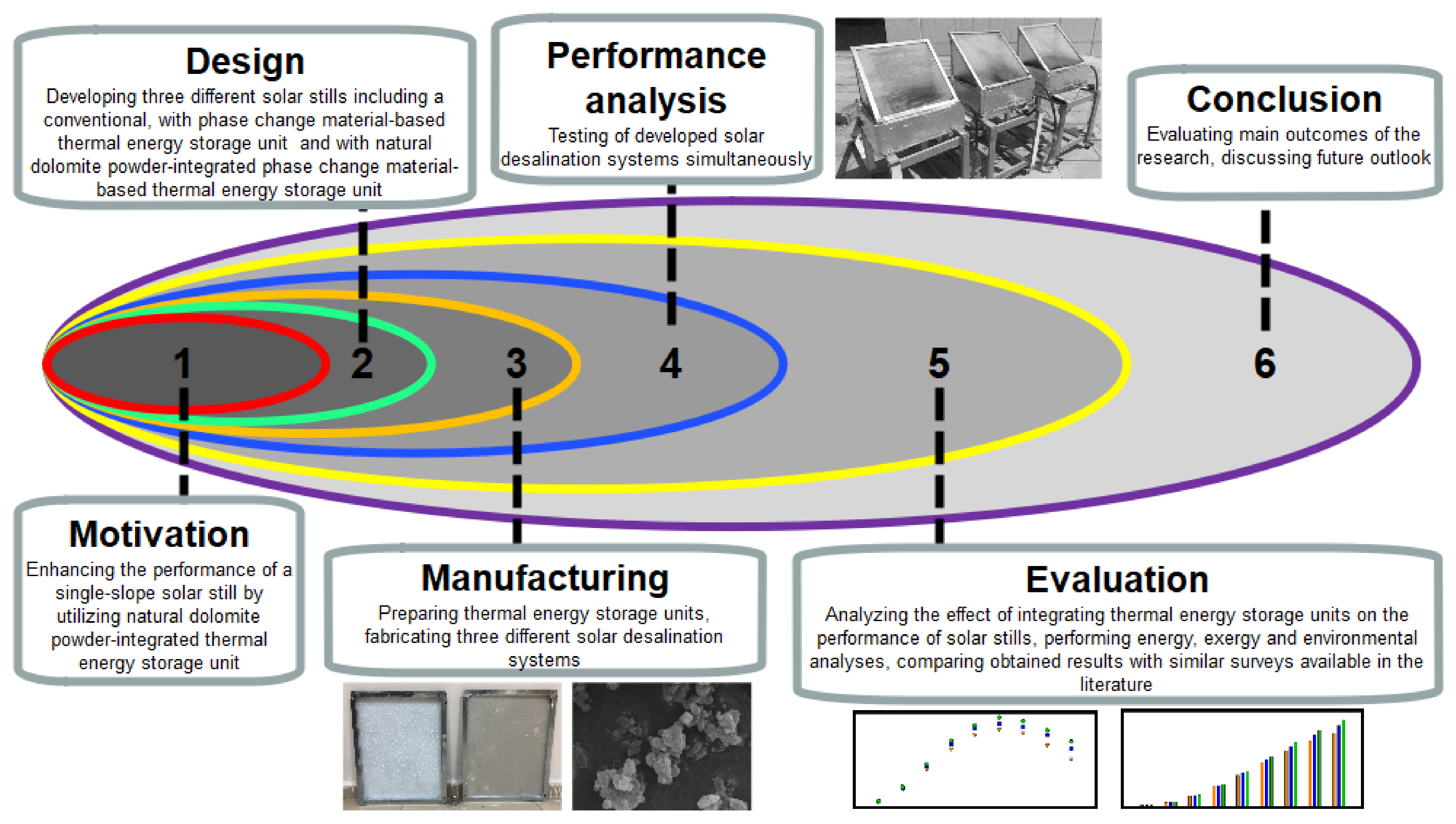
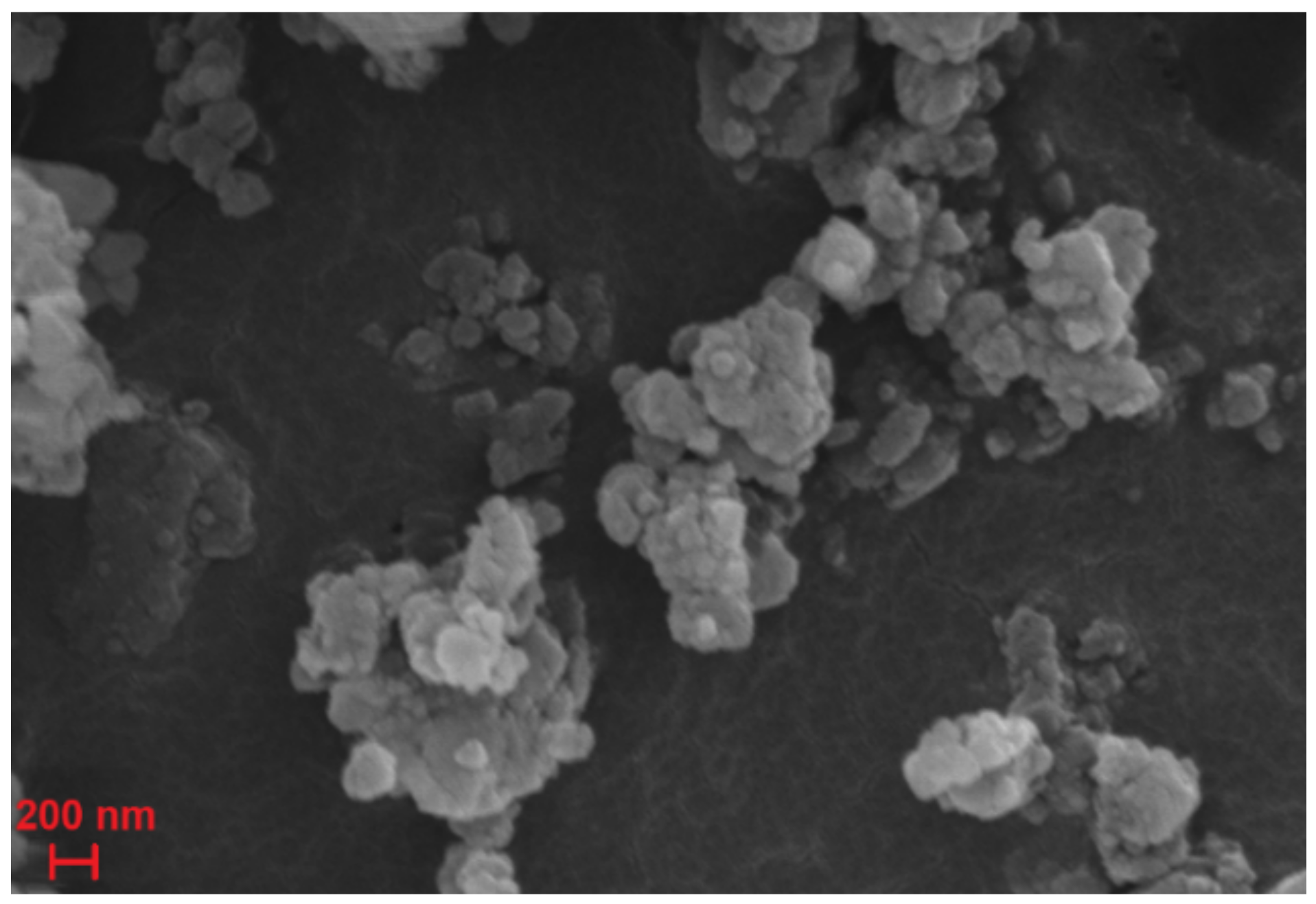
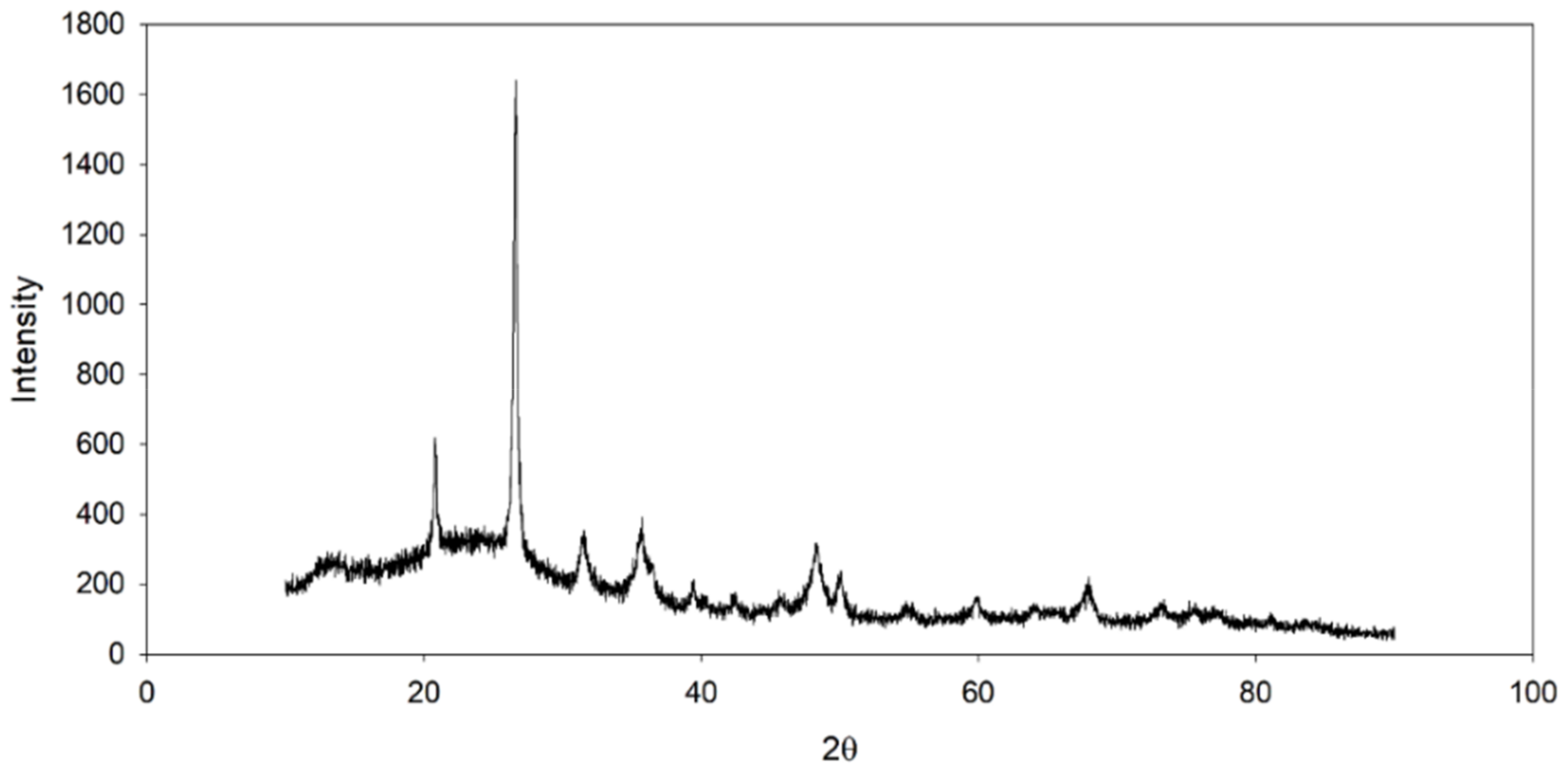
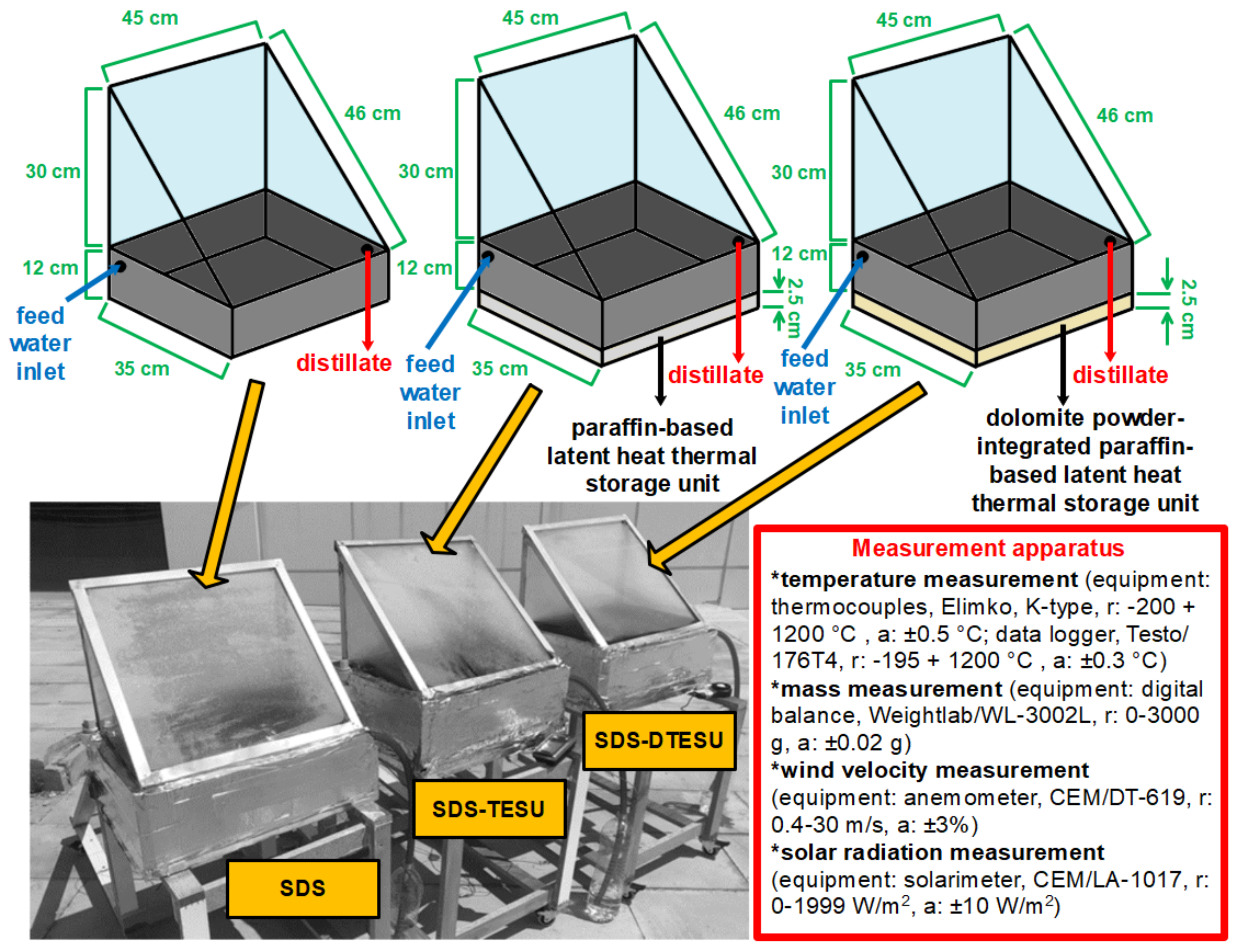
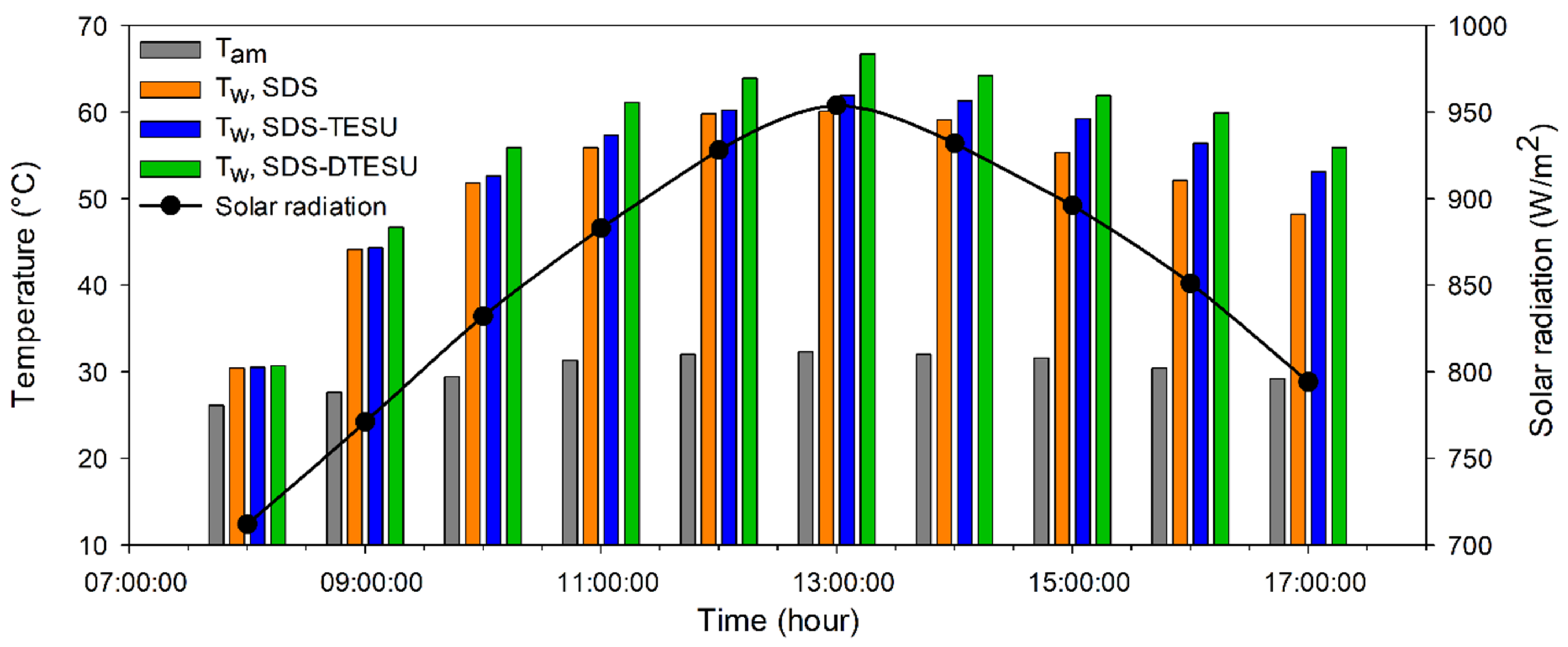
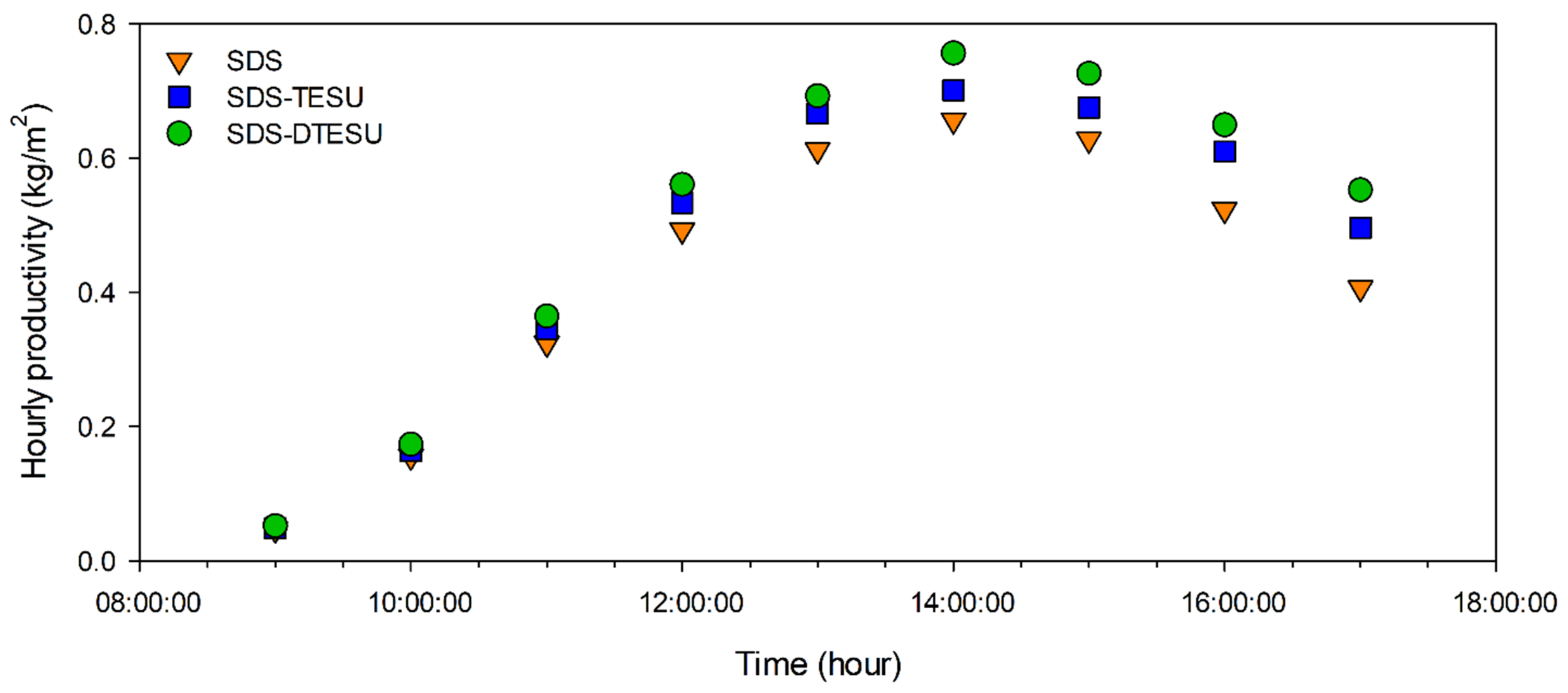
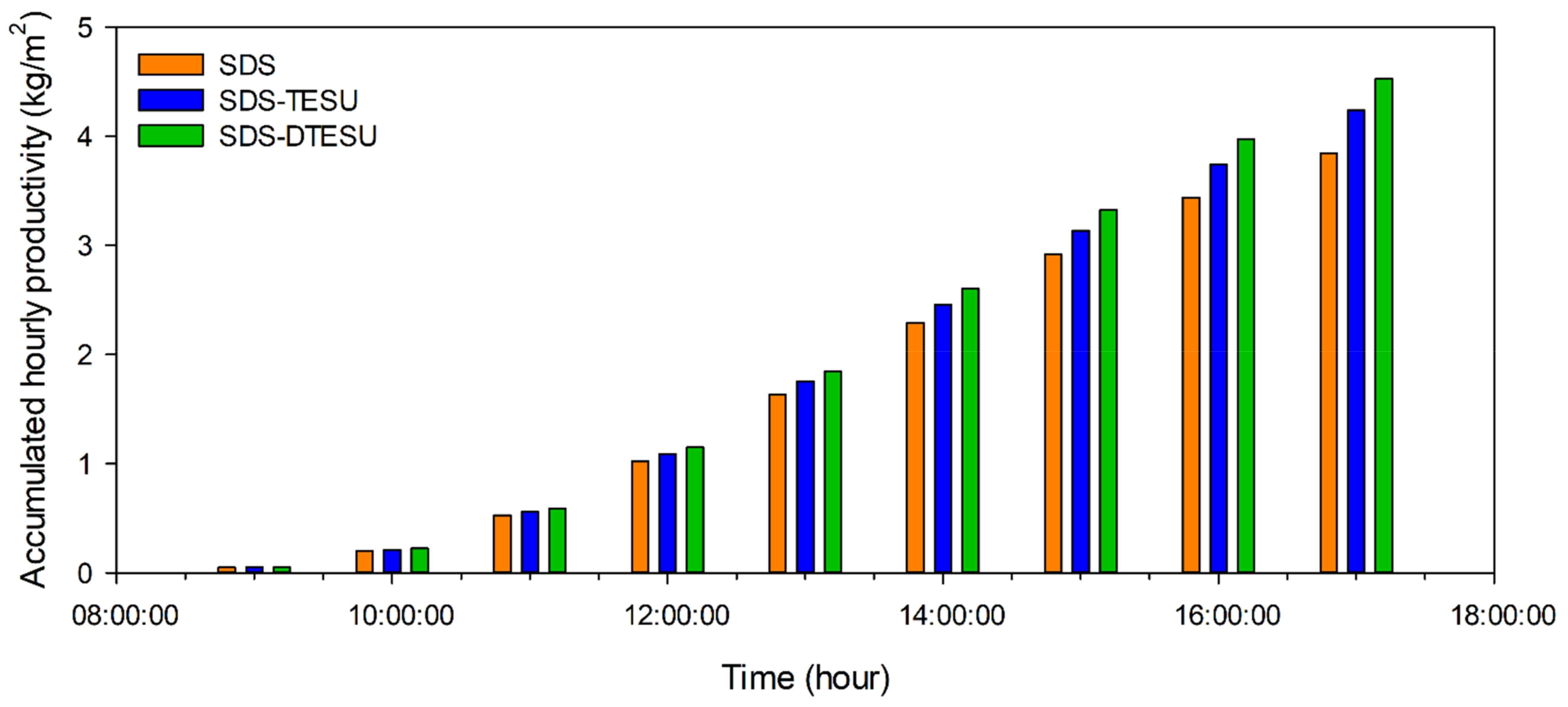

| Ref. | Geometry | Bottom Area (m2) | Modification | Energy Efficiency (%) | Yield Increase (%) |
|---|---|---|---|---|---|
| [63] | Single- and double-slope | 1.5 | Parabolic trough collector | 22.39–32.59 | 90.40 |
| [93] | Single-slope | 0.25 | Photovoltaic panel and external condenser | 27.17 | 39.49 |
| [94] | Cuboid | - | Thermoelectric module and parabolic collector | 13 | - |
| [95] | Pyramid | 1 | Blackened wick | 50.3 | 17.7 |
| [70] | Single-slope | 1 | Finned wick | 55 | 23 |
| [96] | Single-slope | 0.25 | Wick pile of jute cloth | 29.4 | 23.7 |
| [97] | Double-slope | 1 | External condenser, fins, TESU and wick | 39.7 | 22.3 |
| [98] | Tubular | - | PCM and reflector | - | 8.2 |
| This study | Single-slope | 0.157 | Conventional | 15.91 | - |
| Single-slope | 0.157 | TESU | 17.37 | 10.15 | |
| Single-slope | 0.157 | Dolomite powder-integrated TESU | 18.28 | 17.70 |
Publisher’s Note: MDPI stays neutral with regard to jurisdictional claims in published maps and institutional affiliations. |
© 2022 by the authors. Licensee MDPI, Basel, Switzerland. This article is an open access article distributed under the terms and conditions of the Creative Commons Attribution (CC BY) license (https://creativecommons.org/licenses/by/4.0/).
Share and Cite
Selimefendigil, F.; Şirin, C.; Öztop, H.F. Experimental Performance Analysis of a Solar Desalination System Modified with Natural Dolomite Powder Integrated Latent Heat Thermal Storage Unit. Sustainability 2022, 14, 2650. https://doi.org/10.3390/su14052650
Selimefendigil F, Şirin C, Öztop HF. Experimental Performance Analysis of a Solar Desalination System Modified with Natural Dolomite Powder Integrated Latent Heat Thermal Storage Unit. Sustainability. 2022; 14(5):2650. https://doi.org/10.3390/su14052650
Chicago/Turabian StyleSelimefendigil, Fatih, Ceylin Şirin, and Hakan F. Öztop. 2022. "Experimental Performance Analysis of a Solar Desalination System Modified with Natural Dolomite Powder Integrated Latent Heat Thermal Storage Unit" Sustainability 14, no. 5: 2650. https://doi.org/10.3390/su14052650
APA StyleSelimefendigil, F., Şirin, C., & Öztop, H. F. (2022). Experimental Performance Analysis of a Solar Desalination System Modified with Natural Dolomite Powder Integrated Latent Heat Thermal Storage Unit. Sustainability, 14(5), 2650. https://doi.org/10.3390/su14052650







